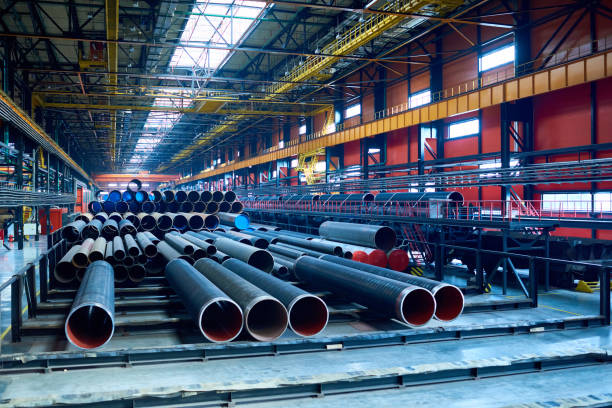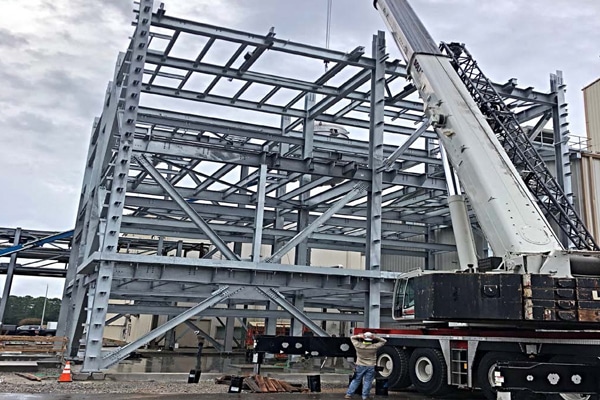Steel Fabrication Melbourne: Workmanship Meets Development
Steel Fabrication Melbourne: Workmanship Meets Development
Blog Article
Cutting-edge Patterns in Steel Fabrication: Enhancing Sturdiness and Accuracy
In the world of steel manufacture, the pursuit of toughness and accuracy has actually brought about a wave of ingenious trends that are reshaping the market. From advancements in welding technologies to the assimilation of robot automation in construction procedures, the landscape of steel production is evolving swiftly. High-strength alloy advancement, coupled with the application of 3D modeling and simulation software application, is pressing the limits of what is attainable in terms of architectural integrity and precision. Furthermore, the growing focus on sustainable practices in steel manufacturing is not only driving effectiveness but also cultivating an extra eco aware strategy to manufacture. These fads are not just shaping today however additionally preparing for the future of steel manufacture, guaranteeing additional improvements in longevity and precision.
Advanced Welding Technologies
In the realm of steel manufacture, the fostering of sophisticated welding modern technologies has dramatically transformed the industry's method to accomplishing superior top quality and accuracy in structural welds. Advanced welding innovations, such as laser beam of light welding and rubbing mix welding, have actually become game-changers in the area. Laser beam of light welding employs a concentrated laser beam of light to join steel parts with impressive precision and speed, making it suitable for intricate designs and thin products. On the various other hand, friction stir welding produces extremely strong bonds by mechanically intermixing the molecules of the products at the joint, eliminating the need for melting the steel. These modern technologies provide various benefits, consisting of decreased heat-affected areas, minimal distortion, and improved mechanical buildings in the welded joints. By leveraging these innovative welding strategies, steel makers can elevate the longevity, stamina, and accuracy of their architectural welds, meeting the significantly demanding needs of modern-day building tasks.
Robotic Automation in Construction
Accepting robot automation has actually become a cornerstone of modern-day steel construction techniques, boosting and streamlining processes effectiveness across the industry. Robotics are transforming the means steel components are produced, offering unequaled precision and speed while reducing human mistake. These automated systems can take care of recurring jobs with consistent precision, leading to better output.
One secret advantage of robotic automation in steel manufacture is the ability to function all the time without tiredness, significantly raising manufacturing result. This constant procedure lessens downtime and speeds up project timelines, eventually saving expenses for suppliers. Furthermore, robots can be set to perform elaborate tasks that may be hazardous or tough for human employees, improving security in the work environment.
Moreover, robot automation enables seamless integration with various other digital modern technologies, such as computer-aided design (CAD) software program and Internet of Things (IoT) systems (metal fabrication melbourne). This interconnected strategy boosts interaction between different phases of fabrication, optimizing operations and guaranteeing real-time monitoring and control. As the steel construction market continues to advance, robotic automation attracts attention as a transformative pressure driving performance and precision in producing processes

High-Strength Alloy Advancement
The innovation of high-strength alloy growth in steel construction is improving the sector's technique to improving material toughness and performance. High-strength alloys are engineered to display exceptional mechanical residential or commercial properties, such as raised tensile toughness, strength, and rust resistance contrasted to standard steel grades. By incorporating these sophisticated alloys right into construction procedures, suppliers can create components that withstand greater stress degrees and extreme settings, leading to even more long lasting and reputable end products.
One key benefit of high-strength alloy advancement is the capability to lower product thickness without jeopardizing structural honesty. This not just causes lighter-weight components however additionally adds to cost savings and improved efficiency in manufacture and assembly processes. Furthermore, the improved strength-to-weight proportion of these alloys permits the style and building of frameworks with greater load-bearing capabilities while reducing general weight.
3D Modeling and Simulation Software
Innovations in steel fabrication processes have actually been substantially propelled by the integration of cutting-edge 3D modeling and simulation software application devices. These devices enable makers to develop detailed online models of their projects, enabling them to visualize the last product with precision prior to any type of physical work begins.

Sustainable Practices in Steel Production
Including lasting methods right into steel manufacturing procedures is essential for reducing ecological influence and making sure lasting resource availability. One essential lasting practice is the adoption of energy-efficient technologies to minimize greenhouse gas exhausts during the steel production procedure. This consists of utilizing renewable resource resources, such as solar or wind power, to power steel plants and executing energy-efficient tools to enhance power use.
An additional important facet of sustainable view steel production is the responsible sourcing of resources. This includes making sure that the iron ore and various other resources utilized in steelmaking are obtained from ethical and environmentally friendly resources. By promoting transparency in the supply chain and adhering to strict environmental criteria, steel makers can decrease the adverse effects of source removal on local environments and areas.

Conclusion
Finally, the innovative fads in steel construction such as sophisticated welding modern technologies, robotic automation, high-strength alloy development, 3D modeling and simulation software, and sustainable methods are improving the sturdiness and accuracy of steel items. These innovations are revolutionizing the steel construction sector by improving quality, sustainability, and effectiveness. It is clear that the future of steel fabrication exists in welcoming these advanced modern technologies to meet the needs of modern-day construction and production industries.
In the realm of steel fabrication, the quest of longevity and precision has actually led to a wave of ingenious fads that are improving the market.In the world of steel fabrication, the fostering of sophisticated welding modern technologies has actually considerably reinvented the sector's technique to attaining superior high quality and accuracy in structural welds. As the steel fabrication industry continues to evolve, robotic automation stands out as a transformative pressure driving efficiency and precision in making procedures.
In addition, reusing and reusing steel scrap and waste products play a considerable duty in boosting the sustainability of steel manufacturing. metal fabrication melbourne.In verdict, the ingenious trends in steel fabrication such as advanced welding innovations, robot automation, high-strength alloy advancement, 3D modeling and simulation software, and lasting techniques are improving the find more resilience and precision of steel products
Report this page